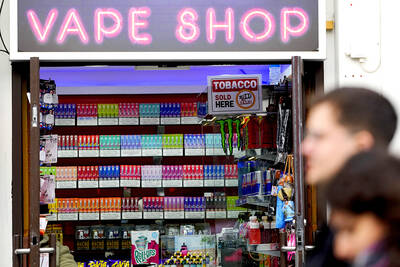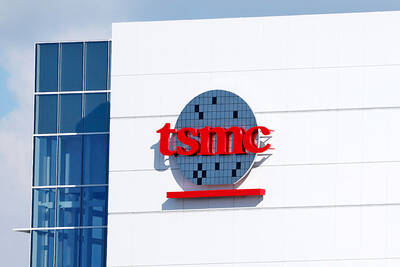Walking between the corrugated iron shacks of the informal settlement west of Johannesburg she calls home, Lutho Makheyi points out trenches filled by dirty rainwater holing the unpaved streets.
These are the scars left by illegal gold mining, a business she blames for the high levels of violent crime that haunt South Africa ahead of a the tightest general election in decades.
“You never know if you’ll be alive tomorrow,” 21-year-old Makheyi said, adding that she hoped the vote would bring about change.

Photo: Reuters
The Johannesburg region is dotted with slag heaps, shafts and deep trenches left by generations of miners, whose arrival in a gold rush in the 1880s led to the city’s birth.
Thousands of illegal miners commonly known as “zama zamas” — “those who try” in Zulu — operate in the area, scavenging, recycling and reworking leftover gold ore. Access to the old mines is often controlled by gangs that sometimes battle for control.
Makheyi’s informal settlement, Zamimpilo, sits atop one such deposit.
Here, ordinary families on years-long government housing waiting lists live side-by-side with miners — both groups constantly fearing for their lives.
Nobukho Novokoza, 38, said her 17-month-old daughter “knows when to duck for cover if gunshots go off”.
“’Mom get down,’” she says when loud bangs ring, Novokoza said.
In Zamimpilo, large pigs feed on waste at a central dumping site as children play nearby.
Residents look on as a miner with a head torch walks past covered in sand. Illegal mines are seen as a hotbed for crime in a country where more than 80 people are murdered every day.
In 2022, the brutal gang rape of eight women who were filming a music video near a mining site shocked the nation.
The government has vowed to wage war on illegal miners, who authorities say are often foreign nationals. Thousands have been arrested since a crackdown last year.
As Agence France-Presse (AFP) visited Zamimpilo, a raid was ongoing, but residents said that most zama zamas had been tipped off. Police officers casually strolled through the settlement. The swoop followed a visit late last year by South African Minister of Police Bheki Cele after several people were killed in a suspected gang shooting.
“They deployed police here for three months but still the illegal mining continued ... under their nose,” Zamimpilo community leader Nokuzola Qwayede, 42, said. “Nothing has been done.”
Authorities say there are more than 6,000 derelict and ownerless mines in South Africa. The government has committed to rehabilitating them and closing abandoned shafts, but experts say corruption makes that harder.
“Our ... intelligence says that some politicians are running the show,” said Dale McKinley, a senior researcher at the University of Johannesburg’s Development Studies department.
Next to Zamimpilo is Riverlea, a working-class suburb. There, religious leader Anthony Sherman would like to see Zamimpilo gone completely.
Men in big-brimmed hats and fancy vehicles park near shafts as they appear to collect goods or money are a common sight, he said.
“The full solution is going to be the removal of Zamimpilo,” he said. “We’re going to eliminate immediately the running battles” and “secure the people.”
Yet some illegal miners say they also live in fear, with gangs adding to the dangers of an infamously perilous work.
“So many people die there in front of me ... I’m scared,” said a miner who preferred not to give his real name and whom AFP agreed to call Thobani Mdunge.
Sporting a dirty torn blue jacket and sweatpants, a body full of scars and an open wound on his lower leg, he had just resurfaced after a week to restock on food.
Mining “disturbs my mental health,” he said.
Gangs sometimes hold miners hostage underground and rob them.
Mdunge has to pay protection money to criminals who kill those who do not cough up. Yet, with little prospect of legal employment, he has no intention of quitting. He and his colleagues recently unearthed gold worth R40,000 (US$2,182) — a hefty sum for many in South Africa.
“For now, I won’t stop this job,” Mdunge said, shrugging.

Real estate agent and property developer JSL Construction & Development Co (愛山林) led the average compensation rankings among companies listed on the Taiwan Stock Exchange (TWSE) last year, while contract chipmaker Taiwan Semiconductor Manufacturing Co (TSMC, 台積電) finished 14th. JSL Construction paid its employees total average compensation of NT$4.78 million (US$159,701), down 13.5 percent from a year earlier, but still ahead of the most profitable listed tech giants, including TSMC, TWSE data showed. Last year, the average compensation (which includes salary, overtime, bonuses and allowances) paid by TSMC rose 21.6 percent to reach about NT$3.33 million, lifting its ranking by 10 notches

Popular vape brands such as Geek Bar might get more expensive in the US — if you can find them at all. Shipments of vapes from China to the US ground to a near halt last month from a year ago, official data showed, hit by US President Donald Trump’s tariffs and a crackdown on unauthorized e-cigarettes in the world’s biggest market for smoking alternatives. That includes Geek Bar, a brand of flavored vapes that is not authorized to sell in the US, but which had been widely available due to porous import controls. One retailer, who asked not to be named, because

SEASONAL WEAKNESS: The combined revenue of the top 10 foundries fell 5.4%, but rush orders and China’s subsidies partially offset slowing demand Taiwan Semiconductor Manufacturing Co (TSMC, 台積電) further solidified its dominance in the global wafer foundry business in the first quarter of this year, remaining far ahead of its closest rival, Samsung Electronics Co, TrendForce Corp (集邦科技) said yesterday. TSMC posted US$25.52 billion in sales in the January-to-March period, down 5 percent from the previous quarter, but its market share rose from 67.1 percent the previous quarter to 67.6 percent, TrendForce said in a report. While smartphone-related wafer shipments declined in the first quarter due to seasonal factors, solid demand for artificial intelligence (AI) and high-performance computing (HPC) devices and urgent TV-related orders

MINERAL DIPLOMACY: The Chinese commerce ministry said it approved applications for the export of rare earths in a move that could help ease US-China trade tensions Chinese Vice Premier He Lifeng (何立峰) is today to meet a US delegation for talks in the UK, Beijing announced on Saturday amid a fragile truce in the trade dispute between the two powers. He is to visit the UK from yesterday to Friday at the invitation of the British government, the Chinese Ministry of Foreign Affairs said in a statement. He and US representatives are to cochair the first meeting of the US-China economic and trade consultation mechanism, it said. US President Donald Trump on Friday announced that a new round of trade talks with China would start in London beginning today,